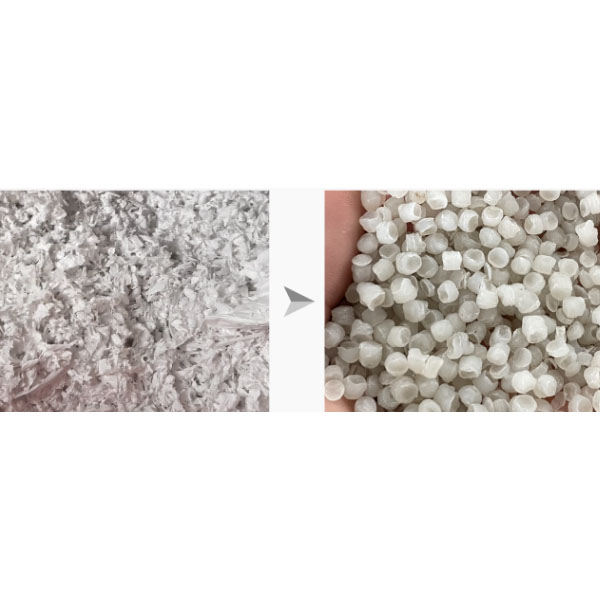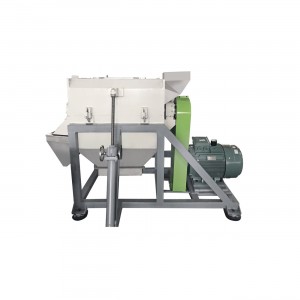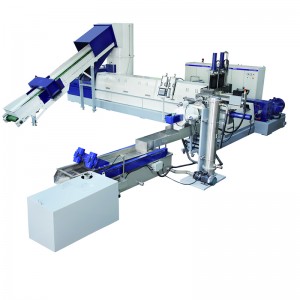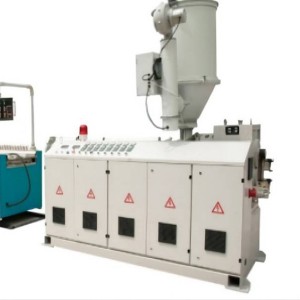Plastic Recycling machine for waste HDPE film(lithium battery separator film)
Plastic Recycling machine for waste HDPE film(lithium battery separator film)
In the production process of lithium battery separator by hydrometallurgy, a large amount of offcut materials (HDPE ultra-high molecular weight polyethylene) will be produced. These offcut(HDPE waste film) can be recycled for pipes, modified plastics and other products, with high utilization value. During the processing of these products, the offcut materials shall be granulated before use. Due to the low melt flow rate of UHMWPE or UHMWPE, extrusion processing is difficult. PURUI provides a new method for degradation and recovery of ultra-high or ultra-high molecular weight polyethylene waste. This method has a simple recovery process, which can be used to degrade and recover ultra-high or ultra-high molecular weight polyethylene in an environmentally friendly and efficient manner, making the polyethylene waste after degradation have good processability, thus realizing the recycling of offcut materials, with good economic benefits.
Plastic recycling line is to break the molecular chain of ultra-high or ultra-high molecular weight polyethylene (UHMWPE) by crushing the film (i.e. the leftover material containing ultra-high or ultra-high molecular weight polyethylene) and then feeding it to the extruder, and then melt extruding under the specific high temperature and the shearing action of the extruder screw, so that the molecular chain of UHMWPE or ultra-high molecular weight polyethylene can be broken, thus having high temperature shearing fluidity and easy processing, realizing resource recovery and reuse, and saving enterprise costs.
Plastic recycling steps:
(1) Crush: crushing HDPE waste film as 30mm by plastic crusher machine and then feeding into agglomerator by belt conveyor.
(2) Extrusion: extruding under the temperature between 160 to 250℃, rotary speed as 60-150rpm, L/D as 30-50
(3) Granulation/pelletizing: melting and extruding materials are cutted by underwater cutting system, final pellets as 2mm
(4) Dryer and collection: after dryer and collecting by silo, the final pellets melt flow about 0.83-1.31g/10min
Video:
Features:
Simple process, low cost
PURUI’s granulation line can realize the recycling of waste materials of ultra-high or ultra-high molecular weight polyethylene, i.e. offcut, and directly use them for the processing of downstream pipes, modified plastics and other products, solving the problem of processing difficulties with traditional methods; In addition, there is no chemical component added during the recycling/granulating process, which will not cause secondary pollution and will be more environmentally friendly; It be achieved the recycling of waste resources, saves costs and has huge economic benefits.
The granulation equipment and recovery method designed by PURUI effectively degrade and recover UHMWPE. The material can melt and flow, and can be re granulated. The material has high mechanical strength.
A plastic recycling and granulating machine is a type of equipment used to recycle plastic waste into granules or pellets that can be reused in manufacturing new plastic products. The machine typically works by shredding or grinding the plastic waste into small pieces, then melting and extruding it through a die to form pellets or granules.
There are different types of plastic recycling and granulating machines available, including single-screw and twin-screw extruders. Some machines also include additional features such as screens to remove impurities from the plastic waste or cooling systems to ensure the pellets are solidified properly. PET bottle washing machine, PP woven bags washing line
Plastic recycling and granulating machines are commonly used in industries that generate large amounts of plastic waste, such as packaging, automotive, and construction. By recycling plastic waste, these machines help reduce the environmental impact of plastic disposal and conserve resources by reusing materials that would otherwise be discarded.
Lithium battery recycling equipment is a type of equipment used to recycle and recover valuable materials from lithium-ion batteries, which are commonly used in electronic devices such as smartphones, laptops, and electric vehicles. The equipment typically works by breaking down the batteries into their constituent parts, such as the cathode and anode materials, electrolyte solution, and metal foils, and then separating and purifying these materials for reuse.
There are different types of lithium battery recycling equipment available, including pyrometallurgical processes, hydrometallurgical processes, and mechanical processes. Pyrometallurgical processes involve high-temperature processing of the batteries to recover metals such as copper, nickel, and cobalt. Hydrometallurgical processes use chemical solutions to dissolve the battery components and recover metals, while mechanical processes involve shredding and milling the batteries to separate the materials.
Lithium battery recycling equipment is important for reducing the environmental impact of battery disposal and conserving resources by recovering valuable metals and materials that can be reused in new batteries or other products.
In addition to environmental and resource conservation benefits, lithium battery recycling equipment also has economic benefits. Recovering valuable metals and materials from used batteries can reduce the cost of producing new batteries, as well as create new revenue streams for companies involved in the recycling process.
Furthermore, the increasing demand for electric vehicles and other electronic devices is driving the need for a more efficient and sustainable battery recycling industry. Lithium battery recycling equipment can help meet this demand by providing a reliable and cost-effective way to recover valuable materials from used batteries.
However, it’s important to note that lithium battery recycling is still a relatively new industry, and there are challenges to overcome in terms of developing efficient and cost-effective recycling processes. Additionally, proper handling and disposal of battery waste is crucial to avoid environmental and health hazards. Therefore, proper regulations and safety measures must be in place to ensure the responsible handling and recycling of lithium batteries.














